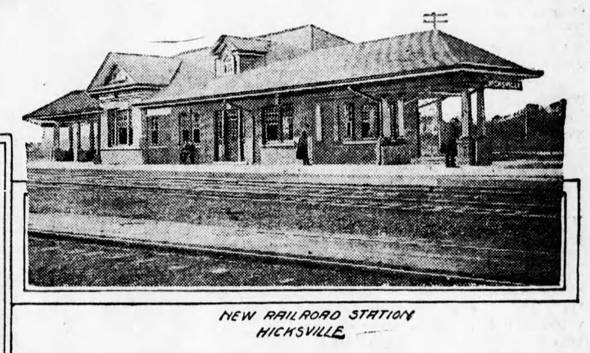Hicksville, the 1911 Version

Brooklyn Daily Eagle, September 3, 1911
As noted here last month, the newspapers of the day offered profiles of various communities on Long Island. The Eagle ran a regular series of such profiles, and about a year after Tunnel Day, it turned its eye to Hicksville and Farmingdale. The contents of the profile which relate to Hicksville are discussed in this section; if you would like to read the entire profile, you can do so by clicking on this URL: https://bklyn.newspapers.com/image/53899087/
The profile tried to demonstrate that both villages were good places for the families of commuters. Indeed, the story begins by suggesting that Hicksville is so desirable that it already is in the midst of a severe housing shortage. Curiously, although the text of the article is balanced equally between the two villages, the photographs are not: Farmingdale gets four of the six photographs - as with the earlier advertisement, perhaps a symptom of the core of Hicksville not being very elegant.
Which parts of Hicksville are used to make a good impression on the reader? First is the new railroad station (and its lovely landscaping!), which had cost $82,000 to build. Incidentally, the Eagle's reporter erroneously states that the depot is at Broadway (this was actually the location of its predecessor), whereas it was just west of Jerusalem Avenue. Very little else is said about the building itself, but there is a lengthy discussion of the LIRR's history, and also mention of a competition among all the line's railroad stations, to win prizes for cleanliness and landscaping.

The only other Hicksville photograph depicts an unlabeled stretch of Mary (soon to be renamed Marie) Street, its broad unpaved roadway flanked by trees and large houses. I imagine that this was the most picturesque view the photographer could find in the time allotted to shoot pictures of two villages No sarcasm is intended; when I was young, I loved walking around the old streets - which by then had been paved; I'm not that old - under their big trees, especially in the autumn.

What is said about the village as a whole?
Determining the population accurately would be difficult, due to the ongoing influx of new residents. The profile estimates it at 3,000, which is inaccurate. Even at the end of 1917, the village had not yet become home to that many people. It states that the citizens of the village have consistently voted to pay for civic improvements, such as cement sidewalks. The village is home to a number of industries, including gold-beating, dressmaking, brushmaking, making food products, and - if things go well - airplane manufacturing. Hicksville's "central role" with respect to the area's farms is acknowledged. Its retail stores are highly recommended, its Fire Department is excellent, its water is good, and its financial institutions are to be praised.
Much attention is devoted to Hicksville's educational institutions. In the school buildings on Nicholai Street (which have benefited from a recent $30,000 expansion), teachers instruct students in grades ranging up through the second year of high school. The total number of students (450) includes some high school students from other communities, whose own schools do not offer education at that level. At the German Lutheran Church, there are classes in German language and literature. St. John's Protectory provides both academic and work-oriented studies for hundreds of resident boys, orphans "from Brooklyn" (an indication that the Roman Catholic Diocese of Brooklyn had confidence in the village, but otherwise, the Protectory's good work was unlikely to attract new residents to Hicksville).
***

